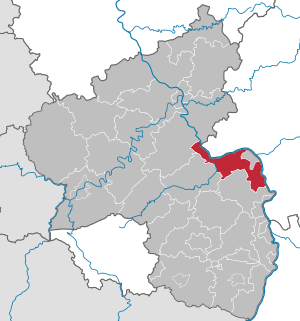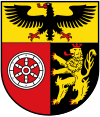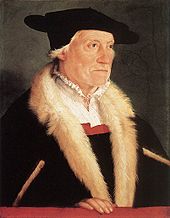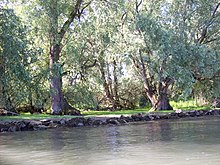Mainz-Bingen district
| coat of arms | Germany map |
|---|---|

|
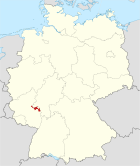
Coordinates: 49 ° 55 ' N , 8 ° 5' E |
| Basic data | |
| State : | Rhineland-Palatinate |
| Administrative headquarters : | Ingelheim am Rhein |
| Area : | 605.77 km 2 |
| Residents: | 211,417 (Dec. 31, 2019) |
| Population density : | 349 inhabitants per km 2 |
| License plate : | MZ , BIN |
| Circle key : | 07 3 39 |
| NUTS : | DEB3J |
| Circle structure: | 64 municipalities |
| Address of the district administration: |
Georg-Rückert-Strasse 11 55218 Ingelheim am Rhein |
| Website : | |
| District Administrator : | Dorothea Schäfer ( CDU ) |
| Location of the district of Mainz-Bingen in Rhineland-Palatinate | |
The Mainz-Bingen district is a regional authority in the east of Rhineland-Palatinate . The seat of the district administration and largest municipality is the association-free city Ingelheim am Rhein , the second largest municipality is the association-free city Bingen am Rhein . The eponymous city of Mainz does not belong to the district, but is independent .
It emerged in 1969 for the most part from the districts of Bingen and Mainz , which until 1945 were the district of Bingen and the district of Mainz in the people's state of Hesse .
geography
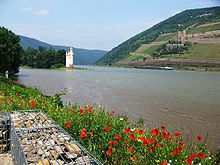
location
The Rhine forms the entire eastern and a large part of the northern border of the district. In Bingen , the Nahe flows into the Rhine after flowing a short distance through the district. Agriculture in the district is dominated by viticulture . This applies both along the Rhine as well as in Rheinhessische hills designated southern part of the circle. The district is characterized by three wine-growing areas: the Middle Rhine , the Nahe and Rheinhessen , Germany's largest wine-growing area . Due to the favorable climatic conditions, special crops such as fruit and vegetable cultivation (e.g. cherries , asparagus ) are well developed in the district.
Neighboring areas
The district borders clockwise in the north, beginning with the Rheingau-Taunus district , the independent cities of Wiesbaden and Mainz and the district of Groß-Gerau (all except Mainz in Hesse ) and the districts of Alzey-Worms , Bad Kreuznach , and Rhein-Hunsrück -Kreis and Rhein-Lahn-Kreis (all like Mainz in Rhineland-Palatinate).
The Mainz-Bingen district is part of the Rhine-Main metropolitan area .
history
The area of today's Mainz-Bingen district was split up into numerous domains before 1792 , of which the Electors of the Palatinate had the largest share, followed by the Electors of Mainz .
In 1794 the Left Bank of the Rhine was occupied by the French in the First Coalition War. In 1798, the administration of the Left Bank of the Rhine was reorganized by the French government based on the French model. From 1798 to 1814, the area of today's Mainz-Bingen district was predominantly part of the Donnersberg (Mont Tonnerre) department with the main town ( chef-lieu ) Mainz, while the area north of the Nahe was part of the Rhine-Mosel department (Rhin-et-Moselle) based in Koblenz. After the Congress of Vienna in 1815, the northern part of today's district (west of the Nahe) came to the Kingdom of Prussia (from 1822 Rhine Province ), the southern part to the Grand Duchy of Hesse in 1816 . Within Hesse, the two districts of Mainz and Bingen came into being on February 5, 1835. The Mainz district emerged from the cantons of Mainz , Niederolm and Oppenheim . On February 16, 1835, the city of Mainz was spun off from the Mainz district as the Mainz-Stadt district. On May 12, 1852, the Oppenheim district was established . On April 7, 1938, the Oppenheim district was dissolved and divided between the Mainz and Alzey districts. During the district reform , the two districts of Mainz and Bingen were amalgamated on June 7, 1969, and some areas of the districts of Kreuznach and Sankt Goar were also included. On November 7, 1970, Genheim from the Bad Kreuznach district was added. Dorn-Dürkheim and Wolfsheim from the Alzey-Worms district followed on March 16, 1974 . The seat of the district administration was initially the Erthaler Hof in Mainz; since January 1, 1996 it has been Ingelheim am Rhein.
History of the district of Bingen
History of the Mainz district
Population development
| Residents |
Deadline |
|---|---|
| 149,800 | May 27, 1970 |
| 157,800 | June 30, 1980 |
| 171,800 | September 30, 1990 |
| 194.200 | December 31, 2000 |
| 200,598 | December 31, 2005 |
| 201.371 | December 31, 2006 |
| 201,970 | December 31, 2007 |
| 201.915 | December 31, 2008 |
| 202.260 | December 31, 2009 |
| 203.026 | December 31, 2010 |
| 203,588 | December 31, 2011 |
| 202.222 | December 31, 2012 |
| 205,657 | December 31 2013 |
| 206.918 | December 31, 2014 |
| 211,307 | December 31, 2015 |
| 211,874 | December 31, 2016 |
| 209.785 | December 31, 2017 |
| 210,889 | December 31, 2018 |
| 210,953 | June 30, 2019 |
Denomination statistics
According to the 2011 census , in 2011 31.9% of the population were Protestant , 38.7% Roman Catholic and 29.4% were non-denominational , belonged to another religious community or did not provide any information. The number of Protestants and Catholics has fallen since then. Currently (as of February 29, 2020) 34.1% of the population are Roman Catholic, 26.9% Protestant and 39.0% either belong to another religion or are non-denominational.
politics
District administrators
- 1969–1976: Heribert Bickel ( CDU )
- 1977–1985: Johann Wilhelm Römer (CDU)
- 1985–1991: Gerulf Herzog (CDU)
- 1992-2017: Claus Schick ( SPD )
- since October 1, 2017: Dorothea Schäfer (CDU)
Dorothea Schäfer prevailed in the runoff election on June 25, 2017 with a share of 65.1% of the vote against Savatore Barbaro (SPD), after none of the original four applicants had achieved a sufficient majority in the direct election on June 11, 2017.
District council
The district council elections on May 26, 2019 had the following results:
| Parties and constituencies |
% 2019 |
Seats 2019 |
% 2014 |
Seats 2014 |
% 2009 |
Seats 2009 |
|
| CDU | Christian Democratic Union of Germany | 30.3 | 15th | 37.05 | 18th | 36.5 | 18th |
| SPD | Social Democratic Party of Germany | 22.8 | 11 | 35.84 | 18th | 31.2 | 16 |
| GREEN | Alliance 90 / The Greens | 19.1 | 10 | 12.71 | 6th | 11.2 | 6th |
| FWG | Free group of voters in the district of Mainz-Bingen | 8.5 | 4th | 9.17 | 5 | 8.7 | 4th |
| AfD | Alternative for Germany | 7.7 | 4th | - | - | - | - |
| FDP | Free Democratic Party | 6.1 | 3 | 4.18 | 2 | 9.4 | 5 |
| THE LEFT. | THE LEFT. | 3.1 | 2 | - | - | - | - |
| ÖDP | Ecological Democratic Party | 1.6 | 1 | - | - | 0.8 | 0 |
| The party | Party for work, the rule of law, animal welfare, elite support and grassroots initiative | 0.9 | 0 | - | - | - | - |
| PIRATES | Pirate Party Germany | - | - | 1.06 | 1 | - | - |
| total | 100.0 | 50 | 100.0 | 50 | 100.0 | 50 | |
| Voter turnout in% | 67.2 | 60.9 | 60.1 | ||||
CDU, SPD and FWG form a coalition in the district council, which has replaced the previous one consisting of the SPD, the Greens and the FWG.
badges and flags
The Mainz-Bingen district has a coat of arms as well as a hoist and banner flag .
| Blazon : "Under a golden shield head, inside a red armored, black eagle, split: in front a six-spoke silver wheel ( Mainz wheel ) in front, in black a red crowned and red armored golden lion ( Palatinate lion )." | |
|
Justification of the coat of arms: The wheel stands for the former Principality of Mainz , the lion for the Electoral Palatinate areas of the district and the eagle indicates the imperial estates at Ingelheim, Oppenheim and Nierstein.
The coat of arms was approved on May 6, 1970. |
economy
The district of Mainz-Bingen is an economically very strong district. This is proven by studies such as the district ranking of the business magazine Focus Money , which regularly sees the Mainz-Bingen district in the top group. In 2014, the district was in first place in this ranking among more than 400 districts and urban districts in Germany. In Rhineland-Palatinate, the district has been in first place every year since the district ranking began in 2003. Other studies such as those of the Berlin Institute for World Population and Global Development, Prognos AG and the “Initiative Neue Soziale Marktwirtschaft” attest that the Mainz-Bingen district has a particularly high level of commitment on the part of its citizens in the voluntary sector, above-average purchasing power of the residents, sustainability and great potential Economic strength. In addition, the district was awarded the nationwide “Kommunalfuchs” award for its overall municipal policy strategy. In the 2016 future atlas , the Mainz-Bingen district was ranked 33rd out of 402 districts, municipal associations and independent cities in Germany, making it one of the regions with “very high future prospects”.
The good economic situation in the Mainz-Bingen district is also reflected in the permanently low unemployment rate, which is well below the national average for Rhineland-Palatinate. In December 2016 the rate was 3.7%. The available household income in the district is also the highest in Rhineland-Palatinate.
Economic structure
In addition to many small and medium-sized companies, large companies such as the second largest German research-based pharmaceutical company Boehringer Ingelheim , Eckes AG (Granini fruit juices, Hohes C) or the Dr. August Oetker KG belonging Budenheim at. Fruit growing is also an important source of income: the cooperatively organized United Fruit and Vegetable Markets Rheinhessen eG (VOG) in Ingelheim is the largest German supplier of sour cherries and mirabelle plums . Viticulture is particularly important in the district. Of the approximately 34,000 hectares of agricultural area in the Mainz-Bingen district, around 35 percent are vineyards. With the Middle Rhine , Nahe and Rheinhessen as Germany's largest wine-growing area, the Mainz-Bingen district has a share in three wine-growing regions. Thanks to the Rheinhessen wine-growing region, the district is a member of the Great Wine Capitals Global Network.
Volunteering
According to the “Engagement Atlas 2009”, the citizens of the Mainz-Bingen district are very active on a voluntary basis. According to this study, more than 50 percent of the district's citizens are civically committed, which puts the district in the highest category and has a “well above average rate of commitment”. From 2007 to 2013, the district supported a total of 763 projects of voluntary initiatives and associations with a total of 13.6 million euros through its volunteer support program. For 2016, a total of three million euros are available for promoting voluntary work.
education
The Mainz-Bingen district has invested around 234 million euros in the district's own schools since 1990. The district is also involved in education through the district adult education center. The Mainz-Bingen district is responsible for the following secondary schools:
High schools
- High school in St. Katharinen Oppenheim
- Nieder-Olm high school
- Sebastian-Münster-Gymnasium Ingelheim
- Stefan-George-Gymnasium Bingen am Rhein
- Nackenheim High School (G8)
Integrated comprehensive schools
- Integrated comprehensive school Kurt Schumacher Ingelheim am Rhein
- Integrated comprehensive school Nieder-Olm
- Integrated comprehensive school Oppenheim
- Integrated comprehensive school Gerhard Ertl Sprendlingen
Realschulen plus
- Rochus Realschule plus Bingen am Rhein with a technical college
- Kaiserpfalz secondary school plus Ingelheim
- Carl-Zuckmayer-Realschule plus Nierstein with technical high school
- Christian-Erbach-Realschule plus Gau-Algesheim
- Lenneberg elementary and secondary school plus Budenheim and Mainz-Mombach
Vocational schools
Special schools
- Rhein-Nahe-Schule Bingen am Rhein, specialization in learning
- Albert Schweitzer School Ingelheim am Rhein , specialization in learning
- Selztalschule Nieder-Olm, special focus on learning
- Landskronschule Oppenheim, special focus on learning
- Elisabethenschule Sprendlingen , focus on holistic development
- Liesel Metten School Nieder-Olm , special focus on motor development (association with the city of Mainz and the district of Alzey-Worms )
More schools
In addition, there are the following secondary schools in the Mainz-Bingen district (not sponsored by the district):
- School Hildegardis school , Bingen am Rhein
- Realschule plus Am Scharlachberg, Bingen am Rhein
- Elementary and secondary school plus, Budenheim / Mainz-Mombach
- private Hildegardis vocational school, Bingen am Rhein
- Bilingual Montessori school, Ingelheim am Rhein
- Steinhöfelschule , private business school, Heidesheim am Rhein
Culture
In addition to Carl Zuckmayer from Nackenheim, known for his “Captain von Köpenick” or the drama “Des Teufels General” , as well as the poet Stefan George from Bingen and the Nieder-Olm-born writer Wilhelm Holzamer , Hildegard von Bingen , who “ great woman of the Middle Ages ”, known nationwide as a personality from the area of today's district. The likeness of the cosmographer Sebastian Münster , who was born in Ingelheim, adorned the old 100 DM banknote. The engraver and publisher Matthäus Merian left his mark in Oppenheim. The ancestors of the painter Adam Elsheimer came from today's Stadecken-Elsheim. A larger audience, for example, is also familiar with the writing winemaker Andreas Wagner, whose wine crime novels are published by Leinpfad Verlag in Ingelheim . To promote today's cultural life, the foundation "Culture in the district" Mainz-Bingen was founded in 1993, which organizes and supports cultural events itself.
Festivals and cultural events
In addition to the Carnival, which is typical for the region, with processions and meetings in almost every place, there are a number of wine festivals , such as the Bodenheim Albansfest , the Guntersblumer Kellerwegfest , the Ingelheim red wine festival , the wine presentation on the Rote Hang in Nierstein or the festival of young wine in Gau -Algesheim. The theater plays in Oppenheim, the jazz festival “ Bingen swingt ”, the Carl-Zuckmayer-Festival in Nackenheim or the Rhenish Hessian youth band competition “Rock-N-Pop-Youngsters”, in which the indie band Auletta, for example, are of supra- local importance are of supra-local importance first stage experience. Due to the great importance of viticulture in the district, the wine sensory competition "Best wine nose of the Mainz-Bingen district" takes place every year in Oppenheim, to which participants travel from all over Germany. Wine and culture are also combined in the literary series " Rheinhessen reads ", which offers readings in wineries and taverns throughout the Rhine-Hesse region. The Jakobsberg Talks are a series of talks regularly organized by the Mainz-Bingen district in Jakobsberg Monastery near Ockenheim , to which executives from business, society, politics, church and administration are invited as speakers. The focus is on socio-politically relevant issues. The Jakobsberg Talks took place for the first time in 1996. Well-known speakers to date have included Helmut Thoma , Karl Lehmann , Erwin Teufel , Peter Frey and Nikolaus Schneider , Udo van Kampen and Heinz Buschkowsky .
tourism
Part of the district between Bingen am Rhein and Bacharach is part of the UNESCO World Heritage Upper Middle Rhine Valley . Especially Bacharach with its historic buildings, the city wall preserved, the Stahleck Castle , the castle Stahlberg , the "Old House" and the ruins of the famous Gothic Werner Chapel , a symbol of the Romantic Rhine , it is one of the main tourist destinations. Numerous castles line the Middle Rhine Valley , in Trechtingshausen , the castles Rheinstein and Reichenstein can be visited. The Katharinenkirche in Oppenheim , which is one of the most important Gothic churches in Germany, is also worth seeing . The Oppenheim cellar labyrinth , a 40-kilometer-long corridor and cellar system on five levels below the city, also attracts many tourists. The Landskron castle ruins are the venue for the Oppenheim theater festival and summer concerts. The symbol of Bingen is the mouse tower on an island in the Rhine . The Drusus Bridge , the oldest medieval stone bridge in Germany, is also located in Bingen. The Binger Rochus Chapel is a well-known pilgrimage site in the region . In Ingelheim am Rhein , those interested in history can visit the imperial palace , which was commissioned by Charlemagne and served as his place of government.
Wine
In the entire district with its three wine-growing regions Middle Rhine, Nahe and Rheinhessen, wine plays a major role in tourism. Some locations like the “Rote Hang” in Nierstein are world famous. Many wineries and hostels in the district offer wine adventure holidays. In addition to Riesling , Müller-Thurgau and Dornfelder , Silvaner is also grown , especially in Rheinhessen . The Silvaner cultivation area in Rheinhessen is the largest in the world. Part of the Rheinhessen wine-growing region in the area of the Sprendlingen-Gensingen community is known as the "Rheinhessische Toskana".
Active vacation
Nature lovers can go on hikes or bike rides in the Rhine meadows, which stretch from Budenheim via Ingelheim to Bingen. The riparian forest there is one of the most species-rich areas in Europe. The Rheinburgenweg for hikers also runs in the Middle Rhine Valley . Part of the Rhenish Hessian Way of St. James also goes through the Mainz-Bingen district. For golfers there are golf courses in Budenheim as well as in Mommenheim and Sankt Johann . There is also a dense network of cycle paths with various themed routes such as the fruit route, the Selztal cycle path , the Rhine cycle path or the Amiche cycle path.
Partnerships
The Mainz-Bingen district maintains partnerships with
-
 the province of Verona in Italy
the province of Verona in Italy
-
 the district of Nysa in the Opole Voivodeship in Poland
the district of Nysa in the Opole Voivodeship in Poland
-
 the Rusumo district in Rwanda
the Rusumo district in Rwanda
Both the Opole Voivodeship and Rwanda are partner regions and countries of the State of Rhineland-Palatinate. Established in 1952, the partnership with the province of Verona is the oldest municipal partnership in Europe. The district representatives signed the partnership document with the Nysa district in 2001. There are regular youth exchanges, specialist conferences, projects and meetings with both regions. So far, the district of Mainz-Bingen has made it possible for numerous young women and men from the partner districts to do an internship in the district administration and for students to take part in the international language courses at Johannes Gutenberg University Mainz . As part of the partnership with Rusumo, the friendship group of the Mainz-Bingen district - Rusumo district e. V. founded. Thanks to the membership fees of this association and donations, many aid projects have been implemented in the Rwandan district.
traffic
This area was first developed by the Hessische Ludwigs-Eisenbahn-Gesellschaft : In 1853 the first line ran from Mainz up the Rhine to Worms , further connections in 1858 in the direction of Frankfurt and Darmstadt and finally in 1859 down the Rhine to Bingen with a connection to the one in Bingerbrück (today Bingen am Rhein Hbf) starting routes of the Rheinische Eisenbahn-Gesellschaft to Koblenz and the Rhein-Nahe-Eisenbahn-Gesellschaft - in operation since 1858 - to Bad Kreuznach.
From Bingen, the Hessian Ludwigsbahn opened a connection across Rheinhessen in the direction of Worms in 1870, into which a branch line from Mainz joined Armsheim in 1871 . After the nationalization of this company, branch lines of the Hessian State Railway were added: The most important was the line from Bodenheim to Alzey , opened in 1896 , which in 1900 received a cross connection from Undenheim-Köngernheim to Nierstein. The main line opened in 1902 enabled the direct connection Mainz – Bad Kreuznach via Gensingen-Horrweiler.
Of the four branch lines of the Süddeutsche Eisenbahn-Gesellschaft existing in Rheinhessen , the following routes touched the district:
- 1888 from Sprendlingen towards Wöllstein and
- 1904 from Ingelheim through the Selztal to Jugenheim - Partenheim .
In 1915, the rail network reached a total extent - excluding trams - of 208 km with a few connecting lines in the Bingen area. In four decades the network decreased by almost 70 km:
- 1945: Connecting railways in the Bingen am Rhein area (11 km)
- 1951: Nierstein - Undenheim - Köngernheim ( " Valtinche " , 10 km)
- 1953: Sprendlingen– Badenheim - Fürfeld (4 km)
- 1954: Ingelheim Rheinbahnhof – Jugenheim-Partenheim (22 km)
- 1969: Osthofen - Eich - Guntersblum ( " Altrheinbahn " , 1 km)
- 1974: Osthofen - Hillesheim - Dorn-Dürkheim - Gau-Odernheim (3 km)
- 1985: Bodenheim –Undenheim-Köngernheim– Alzey ( " Amiche " , 17 km)
In the city of Bingen, the electric railway lines of the AG Binger branch lines operated and, just like the overland line Bad Kreuznach – Sprendlingen – Sankt Johann of the Kreuznach trams and suburban railways, also served goods traffic.
The federal highways 61 Koblenz – Ludwigshafen, 63 Kaiserslautern – Mainz and 60 Mainz – Nahetal run through the district . Furthermore, several federal highways and district roads run through the district area, including the B 9 Worms – Mainz – Koblenz and the B 41 Bad Kreuznach – Ingelheim.
cities and communes
(Residents on December 31, 2019)
Association-free municipalities :
- 1. Bingen am Rhein , large district town * (25,899)
- 2. Budenheim (8646)
- 3. Ingelheim am Rhein , large district town (35,193)
Association members local communities , structured according to their affiliation to the association communities :
(Seat of the association *)
Former parishes
The following municipalities have lost their independence since the district was founded in 1969:
- Dromersheim , on April 22nd, 1972 in Bingen am Rhein
- Großwinternheim , on April 22, 1972 in Ingelheim am Rhein
- Schwabsburg , on July 1, 1970 at Nierstein
- Sponsheim , on April 22, 1972 in Bingen am Rhein
- Heidesheim am Rhein , on July 1, 2019 in Ingelheim am Rhein
- Wackernheim , on July 1, 2019 in Ingelheim am Rhein
For lists of the term "area changes" see area reforms in Rhineland-Palatinate
License Plate
On June 7, 1969, the district was assigned the MZ distinctive sign , which had been valid for the Mainz district since July 1, 1956 . It is still issued today.
Until the 1990s, vehicles from the old district of Bingen received license plates with the letter pairs YA to ZZ 1 to 99 as well as with the letters A to R and the numbers from 1000 to 9999.
November 15, 2012, due to the characteristics liberalization also the distinguishing mark AM (Bingen) available.
literature
- Susanne Karkosch / Karin Müller: The Rheinhessen districts (Alzey, Mainz, Oppenheim, Worms) . Darmstadt / Marburg 1973 (= Repertories of the Hessian State Archives Darmstadt, Dept. G 15 District and District Offices ), DNB 730535312 , HStAD inventory G 15 Series: District and District Offices (1816–1968). In: Archive Information System Hessen (Arcinsys Hessen). Finding aid (PDF 124 kB) at Arcinsys Hessen
- Susanne Karkosch / Karin Müller: District Office Mainz - Oppenheim. Darmstadt 1973/2006 (= Repertories of the Hessian State Archives Darmstadt, Dept. G 15 District and District Offices ), HStAD inventory G 15 Series: District and District Offices (1816–1968). In: Archive Information System Hessen (Arcinsys Hessen).
- Susanne Karkosch / Karin Müller: District Office Bingen. Darmstadt 1973/2006 (= Repertories of the Hessian State Archives Darmstadt, Dept. G 15 Bingen), Finding aid (PDF 124 kB) from Arcinsys Hessen
- Dieter Krienke: Monument topography Federal Republic of Germany . Cultural monuments in Rhineland-Palatinate. Mainz-Bingen district . Wernersche Verlagsgesellschaft , Worms:
- Volume 18.1 = cities of Bingen and Ingelheim, municipality of Budenheim, association municipalities of Gau-Algesheim, Heidesheim, Rhein-Nahe and Sprendlingen-Gensingen . 2007. ISBN 978-3-88462-231-5
- Volume 18.2 = Verbandsgemeinden Bodenheim, Guntersblum and Nieder-Olm . 2011. ISBN 978-3-88462-310-7
- Volume 18.3 = Nierstein-Oppenheim Association . 2011. ISBN 978-3-88462-311-4
Web links
|
Further content in the sister projects of Wikipedia:
|
||
|
|
Commons | - multimedia content |
- Website of the district of Mainz-Bingen
- Statistical data for the Mainz-Bingen district at the Rhineland-Palatinate State Statistical Office
- Literature from and about the Mainz-Bingen district in the catalog of the German National Library
- Literature on the Mainz-Bingen district in the Rhineland-Palatinate state bibliography
Individual evidence
- ↑ a b c State Statistical Office Rhineland-Palatinate - population status 2019, districts, municipalities, association communities ( help on this ).
- ↑ Official municipality directory (= State Statistical Office of Rhineland-Palatinate [Hrsg.]: Statistical volumes . Volume 407 ). Bad Ems February 2016, p. 152 (PDF; 2.8 MB).
- ↑ Statistical Yearbook for the Federal Republic of Germany 1972
- ↑ Statistical Yearbook for the Federal Republic of Germany 1981
- ↑ Statistical Yearbook for the Federal Republic of Germany 1992
- ↑ Statistical Yearbook for the Federal Republic of Germany 2002
- ↑ Municipal statistics from the national system EWOISneu of the Society for Communication and Knowledge Transfer mbH (KommWiss) [1]
- ^ District Mainz-Bingen Religion , 2011 census
- ↑ Municipal statistics of the Mainz-Bingen district , accessed on April 2, 2020
- ↑ Helena Sender-Petry: Victory in the runoff election: Dorothea Schäfer is the new district administrator for the Mainz-Bingen district. Allgemeine Zeitung, June 25, 2017, accessed on December 1, 2019 .
- ^ The Regional Returning Officer RLP: District Mainz-Bingen. Final results of the 2019 district assembly. Accessed August 8, 2019 .
- ↑ Helena Sender-Petry: Mainz-Bingen: The coalition in the district council stands. Allgemeine Zeitung, August 13, 2019, accessed on December 1, 2019 .
- ↑ Axel Hartmann: District Ranking 2014: These are the most successful regions in Germany. In: Focus Online . January 6, 2015, accessed October 14, 2018 .
- ↑ http://www.berlin-institut.org/fileadmin/user_upload/Die_demografische_Lage_2011/D-Engagement_online.pdf
- ↑ a b Engagement Atlas 2009
- ^ The INSM profile: Mainz-Bingen district ( Memento from August 20, 2011 in the Internet Archive )
- ↑ DEMO-Kommunalfuchs 2008 ( Memento from January 27, 2010 in the Internet Archive )
- ↑ Zukunftsatlas 2016. Archived from the original ; accessed on March 23, 2018 .
- ↑ Federal Employment Agency - https://statistik.arbeitsagentur.de/Navigation/Statistik/Statistik-nach-Regionen/Politische-Gebietsstruktur/Rheinland-Pfalz/Mainz-Bingen-Nav.html
- ↑ Federal Statistical Office (2010): Regional database. Wiesbaden.
- ↑ Central marketing facility for fruit growing in Rhineland-Hesse. Retrieved March 1, 2020 .
- ↑ Portrait of the district ( Memento from August 30, 2011 in the Internet Archive )
- ↑ District Administrator hands over notices for voluntary work - one million euros distributed in 2013 ( Memento from April 29, 2014 in the Internet Archive )
- ↑ Landkreis Mainz-Bingen - press releases November 2016. (No longer available online.) Archived from the original on March 15, 2017 ; accessed on March 14, 2017 .
- ↑ The highest number of high school graduates in the Mainz-Bingen district ( memento from April 29, 2014 in the Internet Archive )
- ↑ http://www.merian.de/kolumnen/nachgeschenken/a-754873.html
- ↑ http://www.allgemeine-zeitung.de/region/oppenheim-nierstein-guntersblum/oppenheim/10749710.htm
